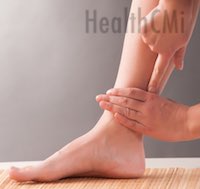Acupuncture point injections of vitamin K ease dysmenorrhea (menstrual pain and cramping). Researchers at the University of California, San Francisco (UCSF) injected vitamin K1 into acupuncture point SP6, located on the lower leg. The women participating in the study experienced less menstrual pain and a shorter duration of menstrual symptoms.  A survey of the participants finds 94% “agreeable to receiving injection therapy” and 77% would receive monthly injections if the treatment were made available. The researchers note, “This finding is consistent with outcomes from the Obstetrics and Gynecology Hospital in Shanghai, China, where the protocol was developed.”
A survey of the participants finds 94% “agreeable to receiving injection therapy” and 77% would receive monthly injections if the treatment were made available. The researchers note, “This finding is consistent with outcomes from the Obstetrics and Gynecology Hospital in Shanghai, China, where the protocol was developed.”
A closely related investigation at the UCSF Clinical Research Center (San Francisco, California) tested plasma concentrations of vitamin K1 (phylloquinone) in patients with primary dysmenorrhea. Samples were collected 1-2 days after acupuncture point injections of vitamin K1 into acupoint SP6. A direct correlation between higher vitamin K1 levels and reduced menstrual pain and cramping was observed. The researchers note that this indicates further research into the role of vitamin K deficiency in inflammation and pain.
There is a historical precedent for research and use of vitamin K in the USA. Routine injections of vitamin K1 are given to infants to prevent hemorrhage, taking advantage of vitamin K1’s anticoagulant properties. The researchers note, “Vitamin K is typically studied in the context of blood clotting and bone health although recent emerging research suggests that vitamin K may have other roles, including reproductive health.” The researchers note that prior studies show a relationship between vitamin K deficiency and menstrual disorders. Additional research demonstrates relaxation of uterine muscle spasms after administration of vitamin K. The researchers add, “Vitamin K therapy may decrease the length of prolonged menstrual flow as a result of its action on prothrombin, a vitamin K-dependent coagulation protein produced in the liver.”
The researchers describe a correlation between Traditional Chinese Medicine (TCM) theory and the current research. They note that the liver is an important organ in the regulation of menstruation and is involved in the movement of qi and blood. They add that acupuncture point SP6 is commonly used in the treatment of menstrual conditions by licensed acupuncturists “because it is a crossing point of the liver, spleen, and kidney channels, which are important in creating, storing, and moving blood.”
About the Acupuncture Point
Acupuncture point SP6 (Sanyinjiao, Three Yin Intersection) is located on the lower leg, 3 cun directly above the tip of the medial malleolus on the posterior border of the medical aspect of the tibia. This is approximately one handbreadth above the tip of the ankle on the inner portion of the lower leg in a depression by the tibia bone.

Traditional Chinese Medicine theory states that this acupuncture point is the meeting point of the spleen, liver and kidney channels. SP6 strengthens the spleen and transforms dampness, spreads liver qi and benefits the kidneys. Licensed acupuncturists use this acupuncture point in the treatment of a variety of disorders including abdominal pain and distention, diarrhea, dysmenorrhea, irregular menstruation, uterine bleeding, leukorrhea, prolapse of uterus, infertility, difficult or delayed labor, nocturnal emissions, enuresis, dysuria, lower limb atrophy, motor impairment or hemiplegia of the lower limbs, vertigo from blood deficiency, and insomnia.
References:
Chao, Maria T., M. L. Callens, C. M. Wade, P. D. Abercrombie, and D. Gomolak. "An innovative acupuncture treatment for primary dysmenorrhea: a randomized, crossover pilot study." Alternative therapies in health and medicine 20, no. 1 (2014): 49-56.
Chao, Maria T., Christine M. Wade, and Sarah L. Booth. "Increase in Plasma Phylloquinone Concentrations Following Acupoint Injection for the Treatment of Primary Dysmenorrhea." Journal of Acupuncture and Meridian Studies (2014). Author Affiliations:
Osher Center for Integrative Medicine, University of California, San Francisco, California.
Institute for East-West Medicine, New York, NY.
Jean Mayer USDA Human Nutrition Research Center on Aging at Tufts University, Boston, Massachusetts.


